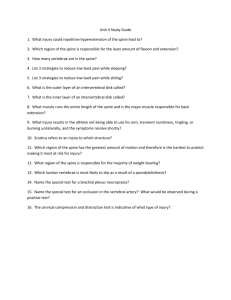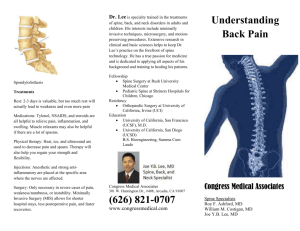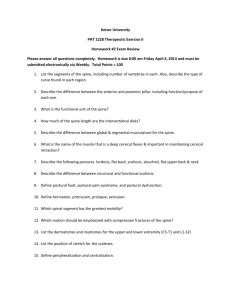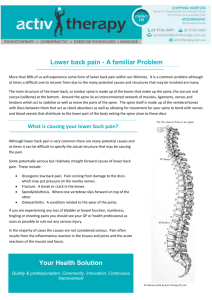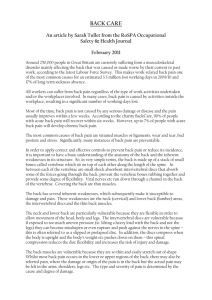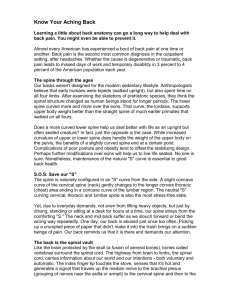HUNCH_NCSSM-Final-Report-for-Wanda
advertisement
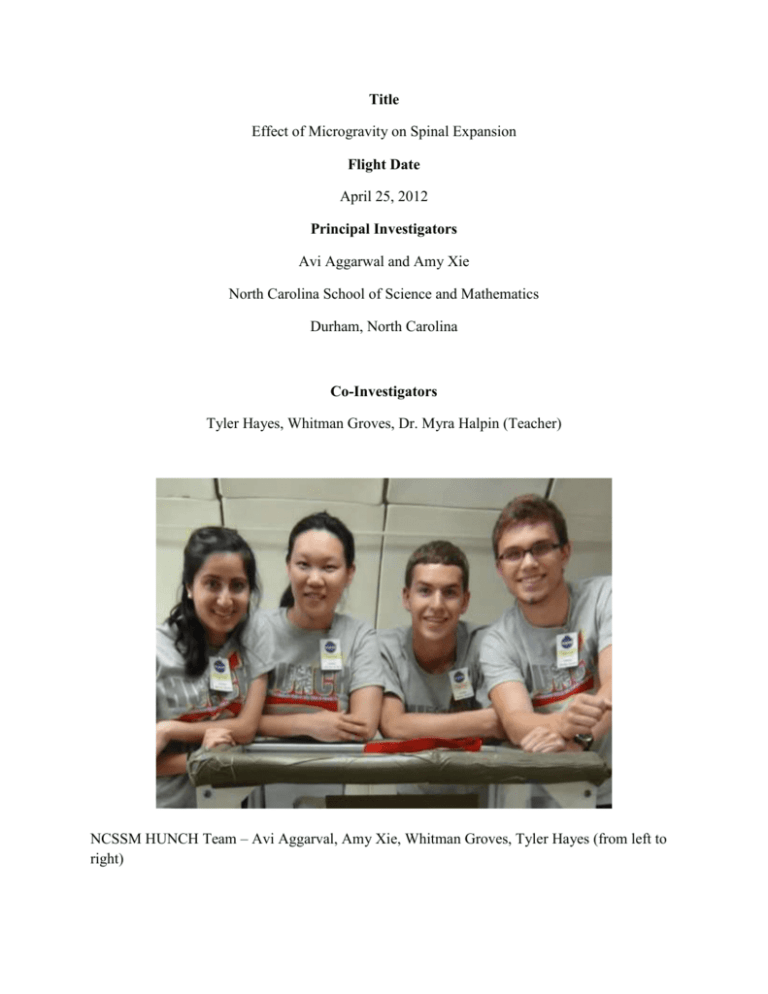
Title Effect of Microgravity on Spinal Expansion Flight Date April 25, 2012 Principal Investigators Avi Aggarwal and Amy Xie North Carolina School of Science and Mathematics Durham, North Carolina Co-Investigators Tyler Hayes, Whitman Groves, Dr. Myra Halpin (Teacher) NCSSM HUNCH Team – Avi Aggarval, Amy Xie, Whitman Groves, Tyler Hayes (from left to right) Goal For our project, we built a model of the human spinal column and tested movement and tension between vertebrae with force sensors, piezoelectric strips, and a video camera. The goal of our experiment was to observe and understand the effects of microgravity on the behavior of the human spine. The data and conclusions drawn from such research could aid in designing methods to ameliorate back pain caused by spaceflight, possibly including new exercises, special clothing/equipment, and potential treatments to improve astronaut health and performance. Objectives This experiment is being flown as a part of the High School Students United with NASA to Create Hardware (HUNCH) program. It was designed, fabricated, and documented by the students at North Carolina School of Science and Mathematics in Durham, North Carolina. The purpose of the experiment is to observe the forces that affect the human spine in microgravity. In 2010 - 2011, Amy Xie and Avi Aggarwal designed a sleeping pod designed to provide personal space, air flow, circadian rhythm stimulation, and ergonomic support for astronauts. This project was submitted to the Conrad Spirit of Innovation Competition and earned the National Space Biomedical Research Institute Award for Human Healthcare in Space in May 2011. For this project, we interviewed 3 former NASA astronauts because they experienced firsthand sleep in space. The astronauts were Barbara Morgan, Bill McArthur, and Jim Voss. One of the issues the astronauts discussed was chronic back pain while on the International Space Station. Often, astronauts would sleep, hugging their knees, so that the pain in their back is relieved some. The exact cause of astronauts’ back pain is unknown, but there are several factors that likely contribute to the discomfort. The microgravity environment is known to cause the human spine to expand vertically, giving astronauts 2-3” of extra height in space. The increased strain on muscles and ligands would result in chronic back pain. In between the boney spinal vertebrae are fluid-filled discs known as intervertebral discs. Fluid behavior changes from 1G to 0G, allowing for gas bubbles that neither move upwards or downwards. The spinal model we flew in microgravity contained both a force component and a fluid tube column to help us better approach the causation of astronaut back pain. Our mission is to better understand the differences between the forces on a spine in space and a spine on Earth. Astronaut health in space is affected by many factors, a major one being microgravity. A notable effect of microgravity is reduced spinal compression in space, which causes the spine to expand in a painful process. Because astronauts frequently report back pain, we seek to identify ways to relieve strain caused by spinal expansion in reduced gravity and test the forces exerted on the spinal column. We constructed a model of the human spine which incorporates polymer vertebrae, memory foam intervertebral discs, and elastic muscles, supported by a central rod and a Lexan plate structure. To test the behavior of the model in zero-gravity, we attached piezoelectric strips to vertebrae to register movement, as well as force sensors to measure change in forces during the microgravity flight. Additionally, a water column was attached to the structure to observe gases emerging out of solution in microgravity, which is another potential cause of pain. A video camera was attached to the bottom Lexan baseplate to visually record changes in the water column during flight and movement of vertebrae. The entire structure was bolted down to the base plate of a vertical glovebox and flown during Reduced Gravity Educational Flight Program/High Schools United with NASA to Create Hardware (HUNCH) flight week. Figure 1: Model of spine Methods and Materials How the research began Our research began with looking at possible factors contributing to spinal elongation and resulting back pain as a result of reduced gravity. There are many potential sources for pain, ranging from muscles, bone, intervertebral discs, the spinal cord, nerves within the spinal column, and many more. We researched the back and consulted several experts to narrow down the most significant source of the spinal expansion to the intervertebral discs. Then we did further research of the anatomy and materials to determine what the best way to model the spine would be, retaining the key structural components and forces that we wanted to incorporate in our system but allowing the model to be buildable and effectively measurable. Description of experiment setup Our experiment required a scale model of the human spine. We began constructing our experimental model using a threaded steel rod bent to emulate the curve of the human spine. Our vertebrae were taken from a medical visual model, and our intervertebral disks were built from memory foam wrapped firmly in tape. Below several of the vertebrae was a small Lexan plate cut to fit the bone model which sensors would be attached to. This spine was secured into a cage with a Lexan base and top plates, which were connected by a series of other threaded steel rods. A third plate was secured in the middle between the top and bottom plates along the same support rods. To measure the expansion of the human spine once placed in microgravity conditions, we used a combination of force sensors, piezoelectric strips, and accelerometers all connected with a LabQuest interface. Four force sensors were attached to the top and bottom plates, each connecting via spring to a respective intervertebral Lexan plate. Any vertical shift in these plates would register a change in force with the force sensors. Piezoelectric strips extended horizontally from the middle Lexan plate and a threaded steel support rod and were connected to other intervertebral plates. Any vertical shift would cause these strips to bend, creating an electric charge that could be recorded in the LabQuests. All data was recorded alongside accelerometer data, allowing us to superimpose any expansion of the spine with the change in gravitational force and study the correlation. A PVC pipe containing red colored water was attached to one of the steel rods along with a ruler behind it. This is to observe the change in volume and emergence of gas bubbles out of water during reduced gravity, potentially indicating gases coming out of solution inside of intervertebral discs, which is a potential source of the frequently reported back pain. A video camera was attached to the base plate to visually record changes within this water column and also the lower end of the spine. Figure 2: Experimental setup The hypothesis Our team’s hypothesis was that the model intervertebral discs would expand during microgravity, causing the spine to expand, resulting in the vertebrae moving apart. This movement would be reflected by visual recording through video, greater magnitude of voltage generated by piezoelectric strips attached to different vertebrae, and changes in value of force between the force sensors and the vertebrae to which they are connected. This data would show whether even short bits of microgravity can cause changes in forces along the spine. We hypothesize that back pain due to spinal elongation is attributed to long durations of muscle and ligand tension. Additionally, we hypothesize that gases coming out of solution inside of the intervertebral discs may cause pain, and we hypothesized that gas bubbles would form within the water column. Research performed prior to the flight The research we did prior to our flight included researching the anatomical structure of the back and spine in order to design and construct our experiment, and then testing the experiment on ground so we could get a feel for how the experiment would test while we were flying on the plane. Before flying our experiment, we ran a series of ground tests on the experiment to determine exactly how we would operate it in microgravity, and to locate any potential problems with the setup. We tested the local function of each force sensor and piezoelectric strip by monitoring only one at a time and putting force on the spine in different nearby locations. This allowed us to not only confirm that our setup was working, but to give us an idea of the magnitude of forces we could expect to see. We did the same thing with each accelerometer, accelerating them in various ways. We also ran tests with our LabQuests set up exactly how they would be on the plane, with all the sensors plugged in accordingly. By doing this we were able to determine the optimal amount of time to record data for, and also establish an effective method of recording, saving, and reinitiating the data collection process. Results Through this experiment, forces on the spine as well as gas bubble formation in fluids were to be tested. Due to technical difficulties securing and maintaining the position of the video camera, footage of the level of the fluid column was inconclusive. Data from the force probes were consistent throughout the duration of the flight, although the interpretation and application of the data collected may vary. On earth (1G), the total force (sum of top force probe measurement and bottom force probe measurement) is consistently 0.0N, and does not change with time. This is expected because positive force exerted on one probe directly correlates with negative force (force in opposite direction) on the other force probe. Neither total force nor acceleration changes in this situation. During the flight, acceleration changed from approximately 0G to 2G according to the parabolic motion of the ZeroG plane. Because the acceleration changes, the force was expected to change proportionally with acceleration, as well. This comes from the physics equation, F=ma, where force equals mass (which remains constant, as no material is added to or taken away from the experiment) multiplied by acceleration. However, when total force was graphed against acceleration (see Fig 3), no correlation between the two was found. Figure 3: Total force vs. Acceleration We were surprised that there seemed to be no relationship between force and acceleration, so we looked back at the measurements of force and acceleration over time, individually. Figure 4: Acceleration vs. Time Figure 5: Total Force vs. Time From Fig 4 and Fig 5, it is evident that both acceleration and force oscillate over time. Fig 6 shows the two overlayed in real time. Figure 6: Total Force and Acceleration vs. Time Fig 6 shows that although both force and acceleration oscillate over time, there is a period shift between the two. This justifies the lack of direct correlation when force and acceleration are graphed against each other. This means that movement of the spine is affected by acceleration, but with a time lag. Discussion The NCSSM HUNCH team arrived at Ellington Field ready to assemble the experiment inside the glove box, but found that the ¼” holes in the base plate of the glove box were not big enough for the ¼” bolts we intended to use to secure down our apparatus. Adjustments to the base plate were made by the helpful NASA crew in the hangar. The video footage of the flight on the Zero Gravity plane was less helpful than we had hoped. Our experiment had a video camera inside the glove box, screwed into a ¼” bolt, and an external video camera with the arm provided by NASA. The intent of the inner camera was to observe any gas bubbles in the tube of liquid, and the outer camera would capture any visible shift in the spinal column. We quickly learned that simply screwing the inner camera onto its threaded bolt stand was not enough to keep it steady, as it frequently swiveled about. A simple adhesive such as tape would have aided the secure placement of the camera. Also, a more effective way to measure gas bubble formation in water is needed. The outer camera, although more steady, was also bumped from time to time by the flyers in the plane. This occurred most frequently during low G’s, when it is possible for one’s feet and body to be floating in the cabin. During our visit at the Johnson Space Center, we were able to tour research facilities and labs. Dr. Sudhakar Rajulu’s lab works on mechanical design of hardware sent into space that accommodates astronauts’ increase in height. He noted that one of the differences between our spinal model and what happens realistically is the increased flexibility of the spine curvature. When making our model, we bent a metal rod into an anatomically correct curvature and put mobile vertebrae and intervertebral discs on this rod. We measured the force of movement of the vertebrae, but did not account for the adjustment in curvature to changes in gravity. In the future, changing the material of the core of the spine to simulate the human spine more accurately should be made a priority; we need a more flexible material that can alter curvature in response to microgravity but still return to its original position afterwards. From building this experiment, the NCSSM HUNCH team learned how to model complex anatomical systems using artificial materials, and adapting to limitations and complications. While the experimental design at the beginning was fairly simple, we discovered that building a payload is always a work in progress – there are always adjustments and ways to make our model more biologically accurate or measurements more precise. Team is essential to the progress of the project. While team members can disagree over a design or which is the best data collection method, we all worked toward the larger goal of a successful and rewarding flight day. Conclusions The data collected from the force probes turned out to be the most useful; therefore we have learned that force probes are effective data collecting devices. However, though the data confirm slight expansion within our spinal model during periods of zero-gravity, other potential confounding factors exist such as vertical movement of the entire spinal column structure. The piezoelectric strips were helpful in showing some evidence of movement, but the nature of this movement cannot be determined from data; piezoelectric compression sensors may provide more useful data for future experiments. The video recorded was not steady, resulting in a lack of reliable visual data. The water column analysis was inconclusive due to inability to keep camera steady, but it is worth further investigation. This experiment served as an excellent pilot study for future experiments of its nature; we now know to focus on reinforcement and structural sturdiness to prevent wobble and to focus on obtaining collecting more useful measurements. Data are mostly inconclusive but suggest topic and experiment are worth looking into. Force sensor readings confirm slight expansion within the model during periods of zero gravity. Recommendations for future modifications include a sturdier structure, an expandable central rod, and replacing ineffective measuring devices with more useful data collection. Eventual data and conclusions drawn could aid in designing methods to ameliorate back pain resulting from spaceflight, possibly including new exercises, special clothing/equipment, and potential treatments. Recommendations for future flight experiments include building a more sturdy structure to get reliable measurements and steady video recording. This would eliminate the possibility of vertical displacement of entire apparatus as a confounding factor in measurements. Another recommendation is changing the central rod through the vertebrae to a more flexible material that can elongate vertically for a more functional model and accurate representation of the spine. Another recommendation is implementing a liquid viscosity similar to that of intervertebral disc fluid in the water column in order to improve validity of data. Both the moon and mars have gravity levels less than that of Earth. Earth’s gravity is 9.78 m/s², whereas Mars’ gravity is 3.711 m/s² and the Moon’s gravity is 1.624 m/s². In these reducedgravity environments, humans are likely to encounter health problems similar to those occurring in zero-gravity. Studying spinal expansion in a range of gravity settings will contribute to our understanding of Space Adaptation Syndrome and the problems and solutions for spinal expansion on the moon and Mars. This will serve to make spaceflight safer and more productive for astronauts. Contact Information Dr. Myra Halpin Halpin@ncssm.edu Dr. Florence Gold Florence.V.Gold@Nasa.gov
